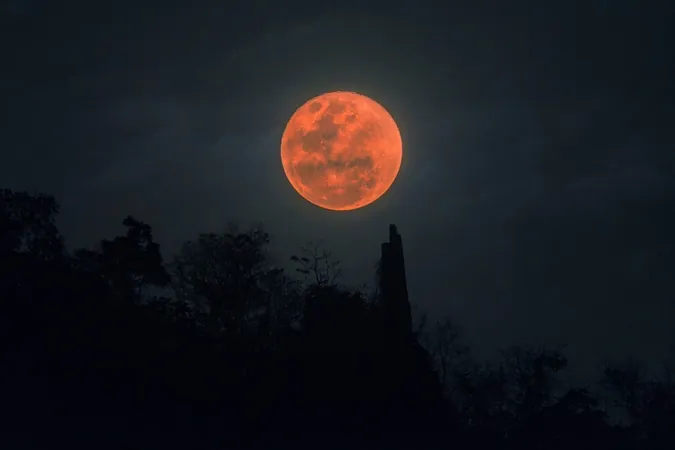
Don't Miss the 2025 Blood Moon Eclipse: A Celestial Spectacle Over America and Europe!
2025-01-03
Author: Arjun
Mark your calendars! A mesmerizing lunar eclipse is set to illuminate the skies over North and South America, as well as parts of Europe, on March 13-14, 2025. While 2025 may not bring a total solar eclipse, this total lunar eclipse promises to be one of the year's most stunning celestial events.
During this captivating occurrence, widely referred to as a 'blood moon,' the full Moon will pass through Earth's shadow, taking on an eerie reddish hue. The entire spectacle will last for over an hour, giving ample time for viewers to revel in its beauty!
What to Expect
This event marks the first total lunar eclipse since November 8, 2022, and is the first of two total lunar eclipses set to happen in 2025. The second eclipse will occur on September 7-8, 2025, primarily observable from Asia, while the UK may catch a glimpse of it on moonrise.
Understanding Lunar Eclipses
A total lunar eclipse happens when Earth stands directly between the Sun and a full Moon, completely shadowing the lunar surface. This shadow play results in the Moon appearing in shades of red, reminiscent of blood, due to sunlight filtering through Earth's atmosphere—a phenomenon similar to why sunsets turn strikingly red.
Eclipse Phases Explained
The lunar eclipse unfolds in five distinct phases, each lasting roughly an hour:
1. Penumbral Eclipse: The Moon enters Earth's outer shadow, causing a subtle dimming.
2. Partial Eclipse: The Moon begins to move into Earth's umbra (the darker shadow), turning reddish.
3. Total Eclipse (Totality): Entirely shrouded in Earth's umbra, the Moon is at its reddest.
4. Partial Eclipse (Ending): The Moon starts to exit Earth's umbra and fades back to its usual brightness.
5. Penumbral Eclipse (Ending): The Moon leaves Earth's outer shadow and regains its glow.
For those eager to witness the 'blood moon' aspect, totality, which lasts 65 minutes, is the prime time to step outside.
Safe Viewing
Unlike solar eclipses, total lunar eclipses can be viewed safely with the naked eye, no special equipment necessary. The Moon appears much more comfortable to observe during an eclipse because the glare is diminished.
Viewing Times Across Time Zones
For North America, here’s when each phase will occur (in Eastern Standard Time):
- Penumbral Begins: 11:57 PM on March 13
- Partial Begins: 1:09 AM on March 14
- Totality Begins: 2:26 AM
- Totality Ends: 3:31 AM
- Partial Ends: 4:47 AM
- Penumbral Ends: 6:00 AM
In Europe, particularly the UK, viewers will witness just the initial phases before moonset:
- Penumbral Begins: 3:57 AM GMT on March 14
- Partial Begins: 5:09 AM GMT
- Moonset: 6:22 AM GMT
Additional Highlights
As night falls during totality, stars and constellations become more visible, and a bright Mars will accompany the eclipsed Moon in the sky. Plus, the atmospheric conditions outside could enhance the reddening effect, making for truly remarkable visuals.
Exciting Future Events
Just two weeks later, on March 29, 2025, a partial solar eclipse will also take place, visible from northeastern North America and parts of Europe. This time, observers should prepare for a unique experience as up to 83% of the Sun might be obscured in certain regions.
Don't miss the chance to be part of these breathtaking celestial events! Clear your schedule, grab a friend, and ensure you're in a location with a good view. The skies are truly set to put on a show!




 Brasil (PT)
Brasil (PT)
 Canada (EN)
Canada (EN)
 Chile (ES)
Chile (ES)
 Česko (CS)
Česko (CS)
 대한민국 (KO)
대한민국 (KO)
 España (ES)
España (ES)
 France (FR)
France (FR)
 Hong Kong (EN)
Hong Kong (EN)
 Italia (IT)
Italia (IT)
 日本 (JA)
日本 (JA)
 Magyarország (HU)
Magyarország (HU)
 Norge (NO)
Norge (NO)
 Polska (PL)
Polska (PL)
 Schweiz (DE)
Schweiz (DE)
 Singapore (EN)
Singapore (EN)
 Sverige (SV)
Sverige (SV)
 Suomi (FI)
Suomi (FI)
 Türkiye (TR)
Türkiye (TR)
 الإمارات العربية المتحدة (AR)
الإمارات العربية المتحدة (AR)